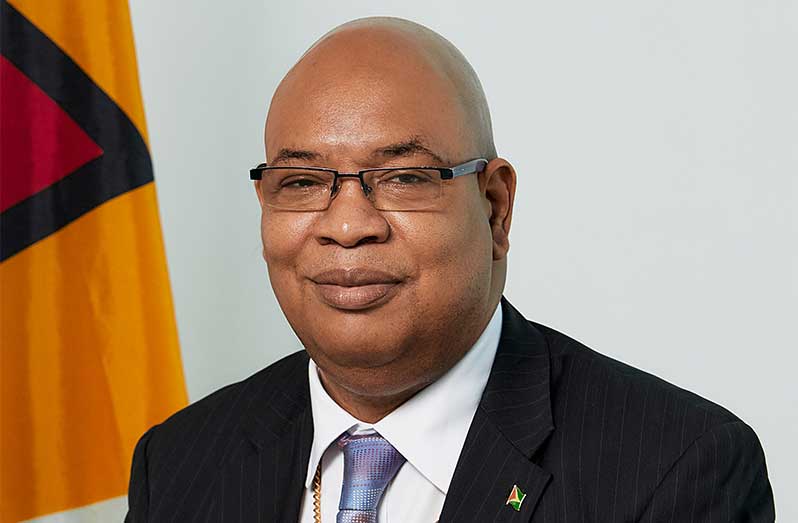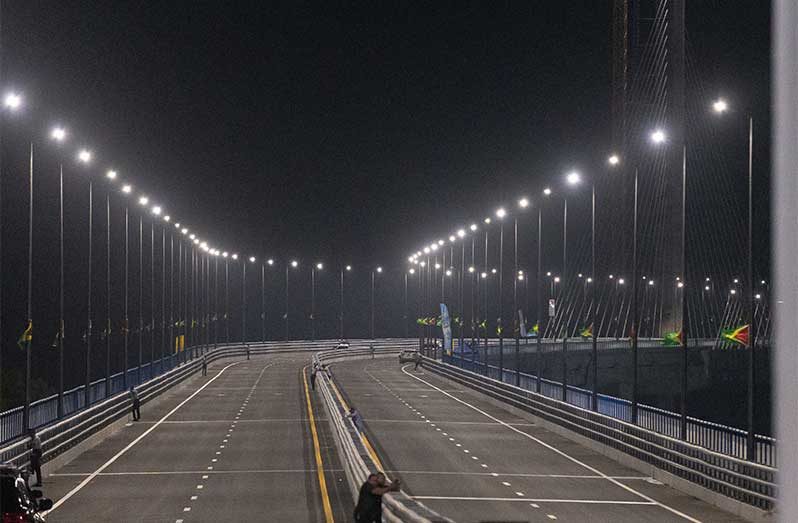MINISTER of Public Works, Juan Edghill, has urged motorists to adopt a new culture of road use—one grounded in the “Five Cs”: care, caution, consideration, common sense, and courtesy—to ensure smooth and safe traffic flow on the newly commissioned Bharrat Jagdeo Demerara River Bridge.
Speaking at a media briefing on Monday, Minister Edghill said the opening of the state-of-the-art four-lane bridge marks the end of the old habits associated with the aging Demerara Harbour Bridge, including rushing to cross during “double-lane” hours and early morning bottlenecks.
The minister was joined by Traffic Chief Mahendra Singh, several senior traffic officers, General Manager of the Demerara Harbour Bridge Corporation, Wayne Watson, and engineers from the Ministry of Public Works.
The briefing was convened to address the first day of full traffic operations on the new bridge, which was officially commissioned on Sunday by President Dr. Irfaan Ali.
Minister Edghill emphasised that the new bridge offers continuous, uninterrupted traffic flow in both directions, eliminating the need for previous practices.
“So, nobody needs to rush out of work or leave home early in the morning unnecessarily to go and join the line to cross the bridge. The days for that are over, and that is why we built what is now known as the Bharrat Jagdeo Demerara River Bridge. Everybody just needs to practise the Five Cs, and everybody will get where they are going.”
Minister Edghill explained that the new Bharrat Jagdeo Demerara River Bridge represents more than just an infrastructure upgrade—it demands a shift in public behaviour.

“We have moved from a two-lane bridge to a four-lane bridge,” he said. “There will be no stoppages in the morning or afternoon, no priority lanes, and no need for panic. Traffic will flow continuously.”
Reiterating that the “old culture” of bridge traffic is now behind Guyanese motorists, the public works minister appealed for co-operation and patience as the nation adjusts to this landmark development.
He said the new bridge symbolises progress, noting that it is faster, safer, and more efficient. He emphasised that this advancement must be matched by a new driving culture built on patience, discipline, and the Five Cs, adding that the bridge will serve the nation well if everyone plays their part.
He noted that the bridge was built to safely accommodate vehicles travelling at 80 kilometres per hour, following extensive testing by both engineers and police officials.
Minister Edghill said he drove across the bridge at 80 kilometres per hour and found the journey smooth and comfortable. He noted that it took only about two and a half minutes to travel from one end to the other, highlighting the efficiency of the new facility.
He acknowledged that some motorists faced confusion on Monday morning, leading to congestion on the western approach.
According to him, he along with senior police officers and the Chinese contractors, visited the site to observe and correct the traffic flow issues.
Minister Edghill explained that the congestion on Monday occurred because not all road users had received adequate information about the new traffic arrangements.
He added that by Monday afternoon, traffic movement across both approaches was expected to improve significantly. He thanked the public for its patience and assured that the government and the police are working closely to monitor and refine the traffic management system as commuters adapt to the new bridge.
A key element of this transition, the minister emphasised, is the proper use of roundabouts, especially those located on the bridge’s approach roads. Educational campaigns are being rolled out to guide drivers on how to navigate them effectively.
Minister Edghill explained that roundabouts are intended to keep traffic flowing and that police will no longer be blocking them. However, he cautioned that motorists who misuse the roundabouts will face prosecution, noting that the new system relies on self-regulation through responsibility and respect.
“The roundabouts going to be allowed to flow, but if you misuse the roundabout, the police will be here to prosecute and to ensure that we have responsible usage,” he said.
Minister Edghill also announced that construction crews are working around the clock to complete the elevated approach road connecting the old Demerara Harbour Bridge corridor to the new structure. This section is about 1.5 metres higher and will require careful engineering to ensure a safe link.
“The new approach road is 1.5 metres higher than the old road, which means you just can’t turn off. There’s going to be a big height—1.5 metres higher. So, everybody just needs to follow the roundabouts, do your thing, get into your two lanes, get on the bridge, discharge, and use the roundabout in a safe way,” he added.
Minister Edghill also indicated that the government is examining plans for a future flyover system to further enhance the efficiency of the new Bharrat Jagdeo Demerara River Bridge.
He explained that while the current roundabout and approach roads are designed to manage existing traffic volumes effectively, the construction of a flyover remains part of the long-term infrastructure vision to accommodate future growth.
The US$262 million bridge, constructed by China Railway Construction Corporation Limited, has a lifespan of 100 years and offers toll-free access.
The new bridge features four lanes and stretches 2,798 metres, linking Nandy Park on the East Bank of Demerara (EBD) to La Grange on the West Bank of Demerara (WBD). At its tallest point, the structure reaches 50 metres, allowing Handymax vessels to pass safely beneath it.
Its design features the Cacique Crown. More than 50,000 daily commuters are expected to benefit from the new bridge, resulting in an estimated $3.5 billion in annual savings.
The project adheres to strict international best practices, with materials tested to the highest standards, and processes meeting ISO benchmarks.





.jpg)








